Dutch Haute Couture designer Iris Van Herpen burst onto the scene in 2007 with her unusual approach to applying innovative 3D printing techniques to her clothing designs.
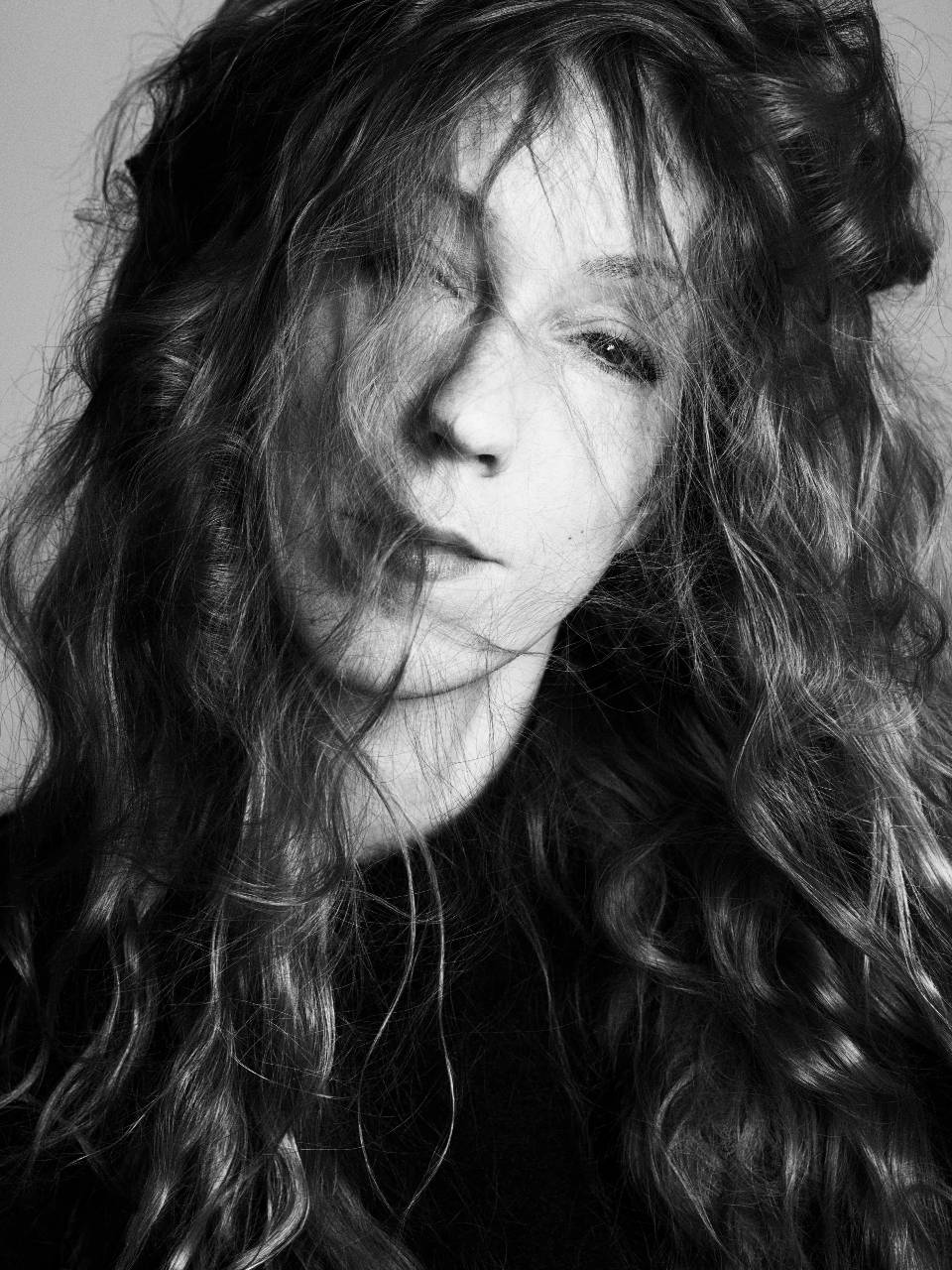
Fusing together technology and Haute Couture craftsmanship, Van Herpen’s unusual approach to design has earned her a unique and loyal following. After launching her own label in 2007, Van Herpen became a guest-member of the Parisian Chambre Syndicale de la Haute Couture in 2011, allowing her to present her collections on a global platform. Now, ten years later, Van Herpen is continuing to innovate and surprise with her designs like no other. She describes her work as “interdisciplinary” as she draws inspiration from professions outside of fashion and the arts. Each season, Van Herpen works in collaboration with experts from other industries in the fields of science, technology and architecture. This allows her to bring together her expertise in fashion with other areas to create something truly unique.
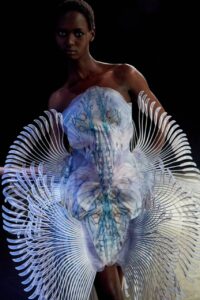
Van Herpen’s work is a perfect blend of innovation and tradition. Fascinated by the world of traditional craftsmanship she utilises these processes but in new innovative ways that allow her to take her designs to the next level. She is very concerned not just by how her designs look, but by how they move and feel when they are being worn. One of Van Herpen’s biggest fascinations is nature. She looks at nature on a deeper level, delving into the fine details of how nature looks and how it behaves. This has been a key inspiration for her collections over the years. As the world becomes more concerned with sustainability, Van Herpern is ahead of the game. Finding ways to combine nature into her designs on a deeper level through developing her own materials and processes that will allow for a more sustainable collection.
The Spring/Summer 2021 Haute Couture collection “Roots of Rebirth” further highlighted Van Herpen’s fascination with the natural world. The designer referenced the intricacy of fungi and the entanglement of life that breathes beneath our feet. Something so simple, but when analysed deeply, it is so intricate and complicated yet beautiful at the same time. She explores the aesthetics, movement and life process of fungi through this collection. Here we find out more about the latest designs and Van Herpen’s ambitious plans for a future of sustainable fashion.
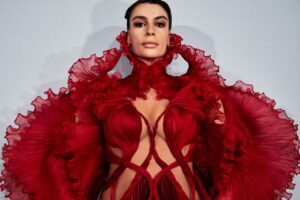
Tell us about your Spring/Summer 2021 Haute Couture Collection “Roots of Rebirth.”
Throughout the isolation period, I read a book called “Entangled Life” by scientist Merlin Sheldrake. It talks beautifully about the way plants communicate with each other, and it’s very similar to how we as humans are communicating at the moment. It’s through a network called the “wood wide web” that connects plants, trees and all living things. They help each other with nutrients as an interconnected community that’s invisible but very inspiring to understand. It’s a newly discovered concept and I felt really inspired by it. On one hand, the book is scientific but it’s very poetic too. It talks beautifully about our future and how we can use fungi to create new types of materials because it is something very resilient. Fungi grow really fast, and I believe they are going to be our future partners in terms of cleaning up the waste on the planet. Fungi can become anything from materials similar to plastic to radioactive materials. It’s inspiring to know that there is hope; even in the mess we create!
I also collaborated with an artist this season on new materials using wood from plants to create lace. It all clicked together and felt like a good moment to show the beginning of what will be a long chapter. The whole focus on sustainability has become huge within fashion and this won’t be a pandemic-only move, it’s something that will stay within the industry moving forward. Everyone is improving materials and techniques. Of course, we have had a hard time with the pandemic, but on the other hand, I feel that the last year has been a good year to collaborate and focus on using more sustainable materials because we have had more time to work on these. We have set up so many new partnerships with companies on a sustainability level. So this is just the beginning of a long story.

Much of your time designing this collection was spent in lockdown or isolation – how did this year affect your creativity?
The hardest part has been the collaborations. They have become more local, which actually, I think is also a good thing. I see fashion as an interdisciplinary platform where scientists, architects, biologists etc. can all be part of the evolution and the creation of garments. We therefore collaborate with different institutes and people and so it has been hard when it comes to communication. Previously, I would travel to meet them or they would come to the atelier and they would be able to get a better feeling of the materials we work with, but now everything is done over video call and it’s great that we can do that, but in terms of creativity, we’re missing out on the best part of the experience. I have had to learn how to adapt because my design process has always been very physical. I drape on a mannequin and that hasn’t changed – but when it comes to experimenting with materials, it’s often a very collaborative process and that has been a lot harder. There have been ups and downs but I must say that I look forward to the post-pandemic-era.
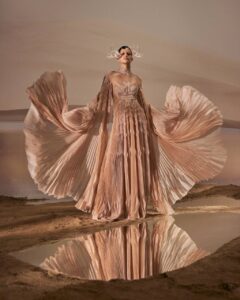
What is the message you want to convey with the collection this season?
I think the message has been very much about sustainability and innovation within sustainability. One project that I enjoyed working on within the collection was the Parley for the Oceans collaboration where we worked on new materials made from plastic found in the ocean. The qualities of the materials are now really of a ‘couture quality’ which is incredible. We have been working on collaborations on all kinds of fabrics within sustainability for quite a few years now, but often you could still notice small differences in the texture, the way it would drape or even the quality of the colour in prints, but now we are really at a point where the recycled fabrics are of the same quality as the usual couture silks and I think that is a really special and important moment. The quality is that high that it doesn’t just need to be saved for the runway, it can also be translated to the looks that we create for the clients.
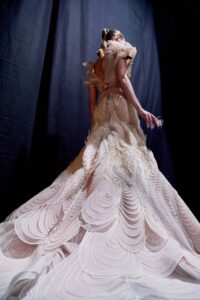
What do you think women are looking for from Haute Couture designs today?
I think they are looking for both quality and sustainability and maybe even more! I think they want a very unique look, but also an insight into the whole process in terms of how the looks are made and the materials that are used. There is more awareness from clients today and they are also looking for a personal process. Clients want works of art that you create together with them; it is not just about fashion anymore. I believe it’s closely connected to the way we buy art. It’s something that you are investing in for the rest of your life so you want a personal connection with it and I think that’s what I like so much about couture – that notion of knowing that I am creating something very personal.
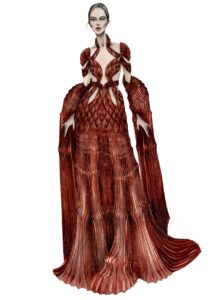
How have you managed to keep in touch with your clients throughout this year?
It has been a real shame not to see my clients. Normally, if we are creating a look for someone we see them several times and these are the most special moments. Now it is all done over Skype and Zoom; we haven’t been able to physically go to visit them or the other way around. Our clientele is very international so it’s been a strange time.
We know you are very much inspired by nature and the beauty in the details of natural objects – what is it about nature that captures your attention so greatly?
Obviously, it is the layers of beauty within nature and the aesthetic aspect, but I think the ultimate attraction for me is to keep nature as part of my design process from start to finish. The growth systems, the forces behind it. The little systems within nature are so incredibly perfect and the way everything depends on each other to sustain life. I think we can learn from nature to create in a better way and I believe that it can become a collaborator within the manufacturing process of fashion. There is still a long road ahead but it’s little steps towards an ultimate goal that will be a fully closed circular system incorporating nature into fashion. I really think it’s possible.
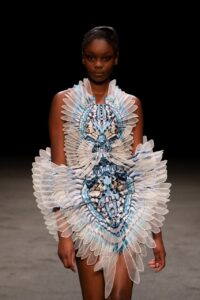
How do you find the experience of presenting your show digitally compared with showing to a physical audience?
We normally have the show in Paris as you know and while we do still have viewers watching online, we of course we have the physical audience too which consists of our clients, press etc. This season everything was digital and the main difference is that our physical audience has not been able to touch the garments or see the textures up close. I think there is magic in the moment of revealing a new collection so I do hope to go back to a mix of physical and digital. I believe both have their own strengths. The inclusivity of sharing a collection online is great as it means that so many people get to see it around the world, but on the other hand, my work is so layered and textured and detailed and it is a different experience when you see it up close. But I hope that next season it might be possible to show the collection in Paris with a combination of the two, we’ll have to see. This experience has definitely highlighted the value of the physical show and how special those moments in Paris are, but at the same time, I feel lucky that we are still able to create and that everyone is still looking to move forward, even if we are still in difficult times.

Your designs combine tradition with innovation – how do you find a perfect balance between the two?
It’s in my nature to do this. One of the reasons I wanted to work in Haute Couture is because I have a great passion for craftsmanship. I wanted to study historic craftsmanship and to keep that alive. For many years now these traditional techniques have been getting lost. There’s not a lot of education available on it and there’s not a lot of people that can execute some of these crafts. So on one hand, I feel it’s really beautiful to be part of keeping these traditional crafts alive and to be part of that long evolution, but on the other hand, I feel I want to bring my own language into it. We are living in the 21st century, our world is changing so rapidly and all the technology that we have available means there is so much innovation available out there that applies to the fashion industry and can be translated into fabrics, new materials etc. and I think it’s beautiful to explore this and create new hybrids between them. To me, it’s a way of bringing my DNA to the craftsmanship that has been passed down to me from the people before me and I really see advantages in the way we can use certain techniques and I see new possibilities with things such as laser-cutting, 3D printing etc. And when you combine all of these techniques, both old and new, there is a whole new world of possibilities. I’m a very curious person and I feel the need to bring those worlds together.
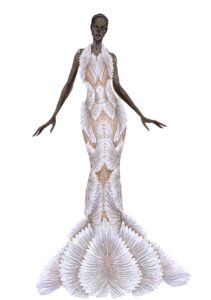
Bridal Couture Collection
Tell us about your bridal couture collection and what do you think is the beauty in designing bespoke pieces for a specific woman?
I think one of the things that I find special is that you are designing for a very precious moment in someone’s life. It feels special to be part of that and to create something that’s very personal for someone. It’s the same when we dress people in the music industry and we are creating something for a special show or performance. It’s about having that piece for that moment. I see weddings as performances too and they are moments that you’ll be celebrating with the dearest people to you and I think that’s magical.
Is there any request that has particular inspired you or been difficult to fulfil?
Every piece has been such a different process. What I think is really special is that the people that come to us don’t want a piece that you see everywhere. They want to push the boundaries and to create a nice balance between art and fashion. And that’s why I guess, every look is a challenge. The garments we make are very focused on movement and transformation and often clients that come to us are looking for that combination of craftsmanship, transformation and the delicacy between the movement of the body and the garment that they are wearing. I think the challenge lies in the layering, in combination with the movement. That’s something that we’ve studied over the last few years and the hybrid of the different techniques is what’s making that possible.
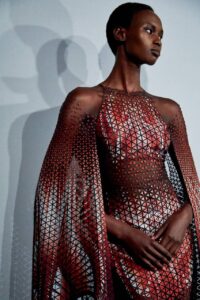
Who is the woman that you design for?
I don’t have a particular woman in my mind when I design. I have a dance background and I guess it’s the idea of the body itself and the way it moves and the transformative power within it that inspires me. I have the woman in my mind as a dancer and I look at the way the body moves. That transformative aspect and the emotion within motion is something that I’m trying to catch within my work and I think it’s really important that after the design is done it creates an identity and that is defined by the woman who is wearing it.
What would you still like to achieve that you haven’t done yet?
I would like to open a museum someday where fashion can closely intertwine with other subjects. A museum that combines fashion, science, architecture and art. That would be really exciting.
We know you are an advocate for women’s empowerment – what makes you feel empowered and how would you like to inspire other women?
I think the first moment in my life when I felt the power within fashion was when I was a child. I would visit my grandma who collected historical garments throughout her whole life. She had a huge collection of incredible garments transcending time and place and I remember dressing up as a little girl in her clothes – even in wedding dresses! Obviously, at that time I had no knowledge of the fashion world but I could feel the power of it. You can really become part of a story when you get dressed and I obviously felt inspired by that then and I think that’s also one of the reasons I went into fashion. It has the power to transform a person. There are no boundaries when you are creating your own identity. I think fashion is a really powerful platform and an instrument for change that inspires us to recreate ourselves and it’s that creative aspect within fashion that is a very powerful one for me.
I think that’s where in my opinion, women have always been very powerful when it comes to fashion. There is a lot more expression and creativity and empowerment within female fashion rather than male and there has always been much more dynamic storytelling in women’s clothing. When I look at my label, we are a very female-orientated company – most of my team are women and I just feel proud that as a woman myself I’m able to have a label like this and to inspire other women to do something that they believe in. I think in the fashion industry we need more female designers as it’s just really beautiful when things are more balanced and I hope to inspire other women to find their own creativity and to dive into the deep end.

What is the professional motto that you live by?
To inspire people to recreate themselves. I believe in female empowerment and independence and I think there is a lot of freedom to be found in creativity. My ultimate goal is to stay independent and to be completely free within my creativity and so far I have managed that and I want to continue this.
What is a message you would send to your clients and friends in the Middle East and can we expect to see you any time soon?
I would love that! I hope I can travel again soon. I’m an optimist so I do have good hope that I’ll be able to travel this year and I really hope to have another special project in the region – either a fashion show or an exhibition. I hope to do more in the Middle East and to share our creativity there.















